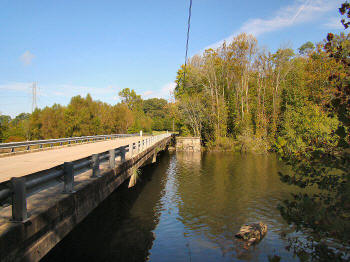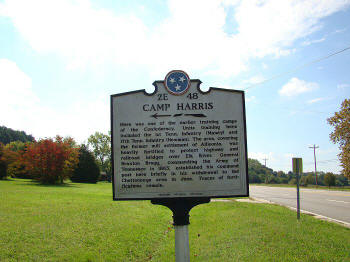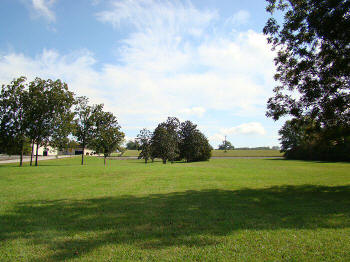|
 (October
2012)
Enlarge Remains of the wartime
Bethpage Bridge crossing of the Elk River, near Estill Springs. View
looking north (October
2012)
Enlarge Remains of the wartime
Bethpage Bridge crossing of the Elk River, near Estill Springs. View
looking north
Enlarged Views: Hit Back Button to return
July 2, 1863 - Skirmish near Bethpage Bridge, Elk River
No circumstantial reports filed.
Excerpt from the Report of General Bush rod R. Johnson, C. S. A.,
commanding brigade, Stewart's Division, Hardee's Corps, during the
Tullahoma Campaign, relative to skirmishes at Bethpage Bridge on July 1
and July 2, 1863.
~ ~ ~
At dawn on the morning of July 1, my brigade, under orders, through Capt.
Helm, from Lieut.-Gen. Hardee, left the cavalry in its rear and moved
toward Decherd. It crossed Elk River by the Bethpage Bridge, and rested
about 1 miles south, near the house of Mr. Corn, from 8 a. m. until about
4 p. m.; then it moved across the Bethpage Bridge, and was place in line
of battle about 11/2 miles in front of it, to support, under command of
Maj.-Gen. Cleburne, Brig. Gen. Churchill's brigade. The enemy fired a few
shots from their artillery, which passed over my command. My brigade then
moved to the left en echelon to Brig.-Gen. Churchill's brigade. At dark my
brigade again crossed the Bethpage Bridge, received order to reduce the
baggage at Decherd to 800 pounds per wagon, and rested during the night
near Mr. Corn's, about 6 miles from Decherd.
On Thursday morning (July 2), my brigade moved back to the Bethpage
Bridge, and passed up to the intersection of the Hillsborough and the
Bethpage and Brakefield Point roads, about 3 miles from the bridge. After
placing my brigade in position across the former road, I sent, by order of
Maj.-Gen. Stewart, the Twenty-fifth Tennessee to join the Twenty-sixth
Tennessee Regt., of Gen. Bate's command, and to support of cavalry under
Gen. Martin at Morris's Ford, on the Hillsborough road. The Twenty-fifth
was detached about two hours and a half, and occupied two positions near
the ford, both out of line of the enemy's fire. A section of Darden's
battery was moved up to Morris's Ford at the same time with the
Twenty-fifth, and took position 250 or 300 yards on the left of the
Hillsborough road, on the bank of the river. The opposite bank, as far as
could be seen along the river and for 200 yards back from the steam, was
covered with woods, in which the enemy's cavalry and perhaps a section of
artillery were posted. Brig.-Gen. Martin's cavalry brigade were stretched
along the southern bank of the steam and were skirmishing with the enemy,
exposed to occasional discharges of canister, shell, and shot. The section
of Darden's battery opened on the enemy at from 250 or 300 yards. It fired
first at the position of the enemy's artillery pointed out by Gen. Martin,
and then shelled the woods. The enemy commenced falling back at the first
shot, and by the time the sixth shot was fired their cavalry had gained
the lane bordered by wide fields beyond the woods, along which they moved
in column presenting an admirable mark for our artillery, and one upon
which every shell seemed to take effect. They were thrown into great
confusion, and many loose horses were seen running away without their
riders. The artillery retired through the fields under cover.
Far up the lane a wagon train was seen, extending into the woods beyond.
They may have been ambulances of a pontoon train. Drivers attempted to
turn and move off, but one or two shells exploded among them and produced
the wildest confusion. The fleeing cavalry and teams became all mingled
together. Gradually the lane was, however, cleared.
~ ~ ~
B. R. Johnson, Brigadier-General, Cmdg.
OR, Ser. I, Vol. 23, pt. I, pp. 608-609. |


